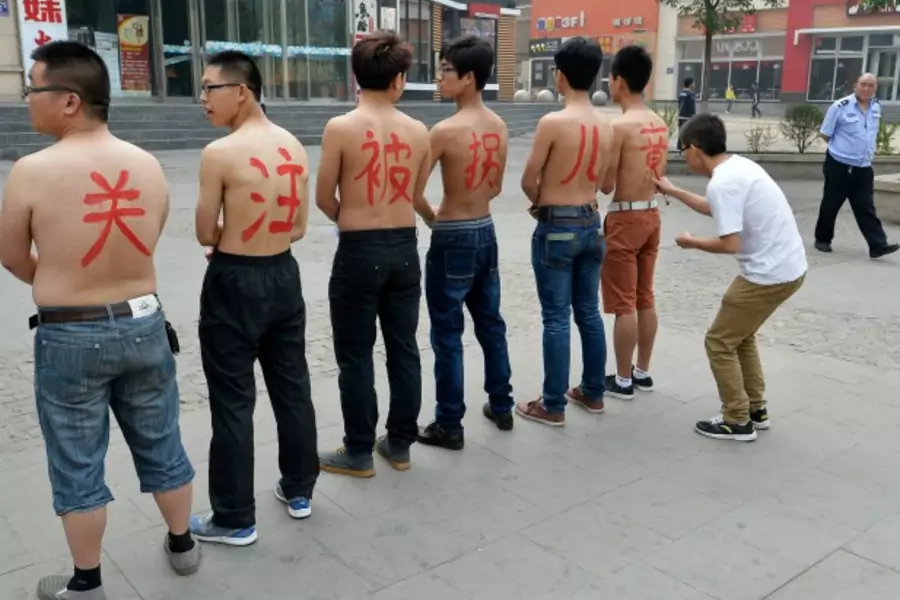Erwin Li: Finding China’s Missing Children

More on:
Erwin Li is an intern for Asia Studies at the Council on Foreign Relations.
Late last month a National People’s Congress inspection group vowed to raise “[the] moral concepts of juvenile protection throughout society.” Besides cases of child abuse and sexual assault, the group has paid special attention to child trafficking—investigating punishments handed out in five provinces since April. But it remains unclear how China wishes to further pursue its goals for child protection; a 2014 U.S. State Department trafficking report did remark on China’s progress, but there’s a far more alarming message to be gleaned: we still know very little about the abduction and sale of children.
China National Radio estimates that roughly 200,000 children go missing in mainland China per year. Official 2013 statistics from India, with its comparable population, put its number at 60,000; the difference suggests the seriousness of China’s child-trafficking situation. While traffickers have reportedly struck deals with corrupt adoption agencies, decades of the one-child policy have exacerbated the problem. With limits on the number of children they can have, Chinese couples have faced immense pressure for a male heir—in turn fueling demand for the illegal adoption black market. On the supply-side, traffickers have resorted to abductions and purchasing babies from rural farmers wishing to avoid steep fines for violating the one-child policy (babies are often sold with prices ranging from 30,000 to 50,000 yuan). To make matters worse, this underground trade has permeated many aspects of society: local government officials have reportedly trafficked children, and a Chinese doctor was recently given a suspended death sentence for selling her patients’ newborns.
To address child-trafficking, Chinese police forces have adopted a broad array of measures. Chinese Ministry of Public Security (MPS) policies include: a national anti-kidnapping taskforce; a DNA database that matches stolen children and their parents; and partnerships with civil society groups like Baobeihuijia (Baby Back Home), which uses social media and the Internet to maintain a running database of missing children. State-sponsored media often make it a point to publicize the results of both local and cross-regional sting operations, as a recent bust in February led to 1,094 arrests and 382 rescued babies. Additionally, articles 240 and 241 of Chinese criminal law prescribe harsh sanctions for child-traffickers; serious offenders can receive life sentences or the death penalty, while buyers of children receive three years or less in prison (the punishment increases if children are abused).
Still, these measures aren’t nearly enough to protect and rescue China’s children. Indeed, the consequences of the one-child policy make addressing the root causes of child trafficking difficult. But at the very least, several reforms can be implemented to minimize social harm. Local police, who have reportedly been averse to accepting cases of missing children, must be held accountable and supervised properly through routine evaluations. Police often refuse to consider a missing child report until after twenty-four hours, and only regulations and sanctions can change this culture. Establishing inspection groups within the national taskforce as well as promoting stronger national-local police ties can help achieve this.
In addition, further space should be afforded to civil society so that it can better complement law enforcement. Citizens should be encouraged to become involved with NGO’s like Baobeihuijia, which require cross-regional linkages and collective action to share information. And to provide interim and or permanent care for rescued children, the government should grant broader financial and institutional support to social welfare homes, which can often only care for orphaned or abandoned children. With the right lines of communication between citizens and police, a public service announcement system—much like the United States’ AMBER Alert—can also be properly implemented. Given the government’s control over information networks, such a measure is not outside the realm of possibility.
None of these changes mean much without transparency, though. For example, while the trafficking bust in February was one of the largest in recent years, authorities failed to mention any details about how they planned to return missing children to their families. Crackdowns and strict laws—while important for signaling deterrence and moral condemnation—are not nearly enough to assuage grieving parents and families that have already lost their children. Instilling hope starts with access to information, not assertions of competence.
The number of missing children in China may be small when compared to the nation’s population. But that doesn’t undercut the issue’s importance. A society complicit with the commodification of a human life puts everyone at risk. China’s top leaders would thus be wise to apply the same political might that they’ve thrown towards anti-graft to human trafficking as well. The relaxation of the one-child policy represents a step, though it won’t likely influence much in the near future. China’s missing children, however, need to be found now.
More on:
 Online Store
Online Store